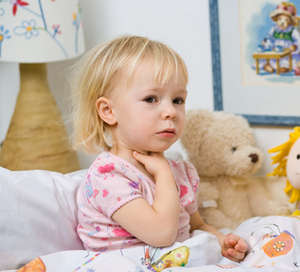
Mononucleosis is a widespread and long-term infectious disease among children, which does not threaten adolescents and the adult population. To apply for medical help, you need to know exactly what symptoms of infectious mononucleosis in children can give out the presence of this disease in a child's body.
 As a rule, in a child, infectious mononucleosis is accompanied by swollen lymph nodes, fever, fever and sore throat.
As a rule, in a child, infectious mononucleosis is accompanied by swollen lymph nodes, fever, fever and sore throat.
Previously, domestic medicine referred to this disease as Filatov's disease, who for the first time in 1885 described its symptoms in children. The disease is caused by the herpes virus, which explains the rash on the skin, and it is the person who is the main source of infection. Infection is possible by airborne droplets in the process:
- cough;
- sneezing;
- kiss;
- through saliva.
In medical practice, infection is most common through a telephone receiver or some kind of toy.
Despite the fact that infection is diagnosed and recorded in children, it happens that infectious mononucleosis is observed in adolescents. If the child is under 10 years old, then the symptoms this disease as if erased, and the very manifestation of the disease is accompanied by general malaise and an increase in body temperature. In relation to adolescents, the treatment of mononucleosis is delayed up to several months.
Symptoms of the disease
Most often, the course of mononucleosis is accompanied by the following symptoms: 
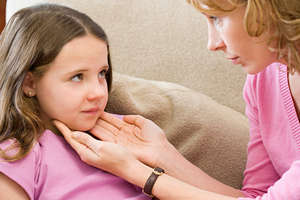
It should be noted that children do not necessarily have all of the listed symptoms during mononucleosis to one degree or another.
Quite often, the disease is slow and sluggish. The child may be extremely tired and will need sleep and rest.
There are other kinds of symptoms that will indicate that the baby has been struck by infectious mononucleosis. In this case, we are talking about a blood test, in which atypical mononuclear cells are detected, unmistakably confirming the presence of this disease.
Diagnosing the disease
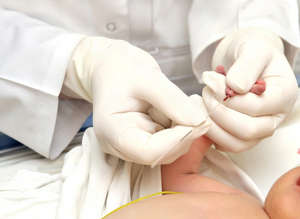 Diagnosing mononucleosis can be difficult in many cases. This is due to the fact that the symptoms of this disease in children quite often indicate a clinical picture that can be typical for many other viral diseases. The main sign that can indicate the presence of mononucleosis in a child is the persistence of certain similar symptoms for a sufficiently long period of time.
Diagnosing mononucleosis can be difficult in many cases. This is due to the fact that the symptoms of this disease in children quite often indicate a clinical picture that can be typical for many other viral diseases. The main sign that can indicate the presence of mononucleosis in a child is the persistence of certain similar symptoms for a sufficiently long period of time.
However, not only the symptoms of this disease in a child will be the basis for the pediatrician, which will allow prescribing a certain treatment. As a rule, two blood tests are taken. The first test is necessary to confirm or deny the presence of heterophilic agglutinins, which is positive in 90% of cases. The second is a blood smear test that may contain atypical lymphocytes.
Extremely rarely present symptoms make it possible to differentiate infectious mononucleosis with angina, rubella, HIV, diphtheria or lymphogranulomatosis.
the symptoms of mononucleosis are disguised as a variety of infectious diseases, which determines the insidiousness of the virus that causes this disease.
Mononucleosis treatment
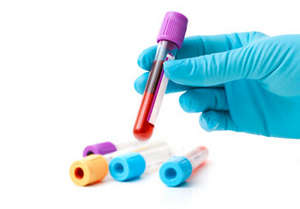 In the event that a child has mild or moderate infectious mononucleosis, then they do not resort to hospitalization, and the treatment itself is carried out at home. It is very important, and this is also emphasized by Dr. Komarovsky ( see video), observe not only bed rest, but also follow exactly all the prescriptions and recommendations of the attending physician.
In the event that a child has mild or moderate infectious mononucleosis, then they do not resort to hospitalization, and the treatment itself is carried out at home. It is very important, and this is also emphasized by Dr. Komarovsky ( see video), observe not only bed rest, but also follow exactly all the prescriptions and recommendations of the attending physician.
In case of enlargement of the liver and spleen, it will be recommended diet number 5... It should be noted that modern medicine has a sufficient number of methods with which it is possible effective treatment mononucleosis.
In particular, therapy consists of:
- elimination of intoxication of the child's body;
- antiseptic throat gargles;
- taking restorative agents;
- symptomatic treatment;
- prevention of possible allergic reactions with the help of medicinal desensitizing agents;
- use, if necessary, antipyretic drugs.
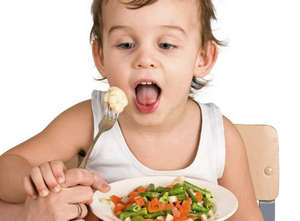 To reduce body temperature in children, pediatricians recommend using exclusively Paracetamol or its analogues. The use of Aspirin is strictly prohibited. The same applies to children under the age of 18. Failure to comply with this recommendation can provoke damage to the brain and liver. In the case of a diagnosis of mononucleosis in a child, treatment with warming is prohibited, since it only aggravates the baby's condition.
To reduce body temperature in children, pediatricians recommend using exclusively Paracetamol or its analogues. The use of Aspirin is strictly prohibited. The same applies to children under the age of 18. Failure to comply with this recommendation can provoke damage to the brain and liver. In the case of a diagnosis of mononucleosis in a child, treatment with warming is prohibited, since it only aggravates the baby's condition.
Also, the treatment of a child for mononucleosis will also consist in limiting the diet, namely, in the exclusion of fats, smoked meats, sweet foods, garlic, onions, legumes and ice cream.
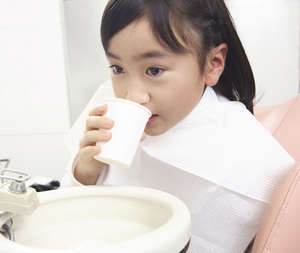 In order for a child to have an effective treatment, it is necessary to adhere to this diet not only during the recovery process, but also for six months after completely getting rid of this disease.
In order for a child to have an effective treatment, it is necessary to adhere to this diet not only during the recovery process, but also for six months after completely getting rid of this disease.
It is also necessary to limit physical activity that can provoke a ruptured spleen. If a child who has been diagnosed with infectious mononucleosis has difficulty in nasal breathing, it is necessary to apply an ephedrine solution, using it no more than five times a day.
It should also be noted that treatment may include splenectomy or surgery to remove the spleen. As a rule, it is justified by the increased size of this organ and increased functionality. In this case, an exacerbation of the course of the disease is quite often noted.
Prevention, as well as the consequences of the disease
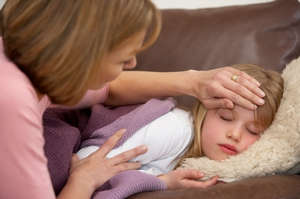 There is no separate set of measures for the prevention of this disease. Therefore, all pediatricians are advised to adhere to the same rules that relate to the prevention of other respiratory viral diseases. However, there is a non-specific prevention of mononucleosis, which is based on increasing the immunity in children in order to create a general resistance of the body to various kinds of diseases.
There is no separate set of measures for the prevention of this disease. Therefore, all pediatricians are advised to adhere to the same rules that relate to the prevention of other respiratory viral diseases. However, there is a non-specific prevention of mononucleosis, which is based on increasing the immunity in children in order to create a general resistance of the body to various kinds of diseases.
In the overwhelming majority of cases in children, infectious mononucleosis ends with their complete recovery.
Rarely enough, any complications are observed, like the consequences that translate this disease into a rank called chronic infectious mononucleosis. In this case, all the consequences are listed below:
- encephalitis;
- meningitis;
- polyneuropathy;
- various mental disorders;
- uveitis;
- febrile syndrome;
- pneumonia;
- a decrease in the number of platelets and / or leukocytes;
- death of erythrocytes;
- rupture of the spleen, which is accompanied by severe pain in the abdomen, decreased pressure, fainting.
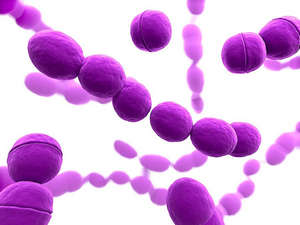 In addition to all of the above, infectious mononucleosis can also be complicated by other kinds of pathologies that cause streptococci, pneumococci or staphylococci. Their ingestion also causes a rash on the skin or mucous membranes of the body. Cases of overlapping of the upper respiratory tract by tonsils are also not excluded.
In addition to all of the above, infectious mononucleosis can also be complicated by other kinds of pathologies that cause streptococci, pneumococci or staphylococci. Their ingestion also causes a rash on the skin or mucous membranes of the body. Cases of overlapping of the upper respiratory tract by tonsils are also not excluded.
In rather rare cases, children have bilateral lung infiltration, accompanied by severe oxygen starvation and / or severe hepatitis. It must be remembered that, based on each specific case, in children this disease can go unnoticed or be accompanied by a train of complications. That is why it is so important to get proper medical attention on time.
Infectious mononucleosis in children is quite common. Parents may mistake him for a sore throat or a cold. How to distinguish the symptoms of mononucleosis in children from other diseases and how to properly treat a baby? This will help the advice of Dr. Komarovsky. What is infectious mononucleosis in children? First, a little theory. Mononucleosis is viral diseasewhich is caused by the Epstein-Barr virus. Most often, mononucleosis affects children aged 3-10 years. Less commonly, infectious mononucleosis occurs in children under 2 years of age. If your baby has a sore throat, sore tonsils, he starts snoring at night, and has difficulty breathing during the day, perhaps he has infectious mononucleosis. The disease is also accompanied by an increase in the lymph nodes, liver and spleen in the child. These are typical symptoms of mononucleosis in children. In addition, a sick child heat , he's lethargic. A blood test helps to accurately distinguish infectious mononucleosis in children from other diseases. Usually, the Epstein-Barr virus is transmitted through saliva. A child can become infected by kissing, through toys, or by airborne droplets. This virus is not very contagious, and infectious mononucleosis is not as common in children as, for example, ARVI. But by the age of 5, at least 50% of children have antibodies to this virus in their blood. This means that the child has already encountered infectious mononucleosis. In many cases, his parents did not even know about it, since the disease often proceeds with almost no symptoms. Those who did not get sick in childhood get sick in adulthood. A sick child has symptoms of mononucleosis for about 2-3 weeks, and then he recovers, no matter how bad he was. Infectious mononucleosis (caused by the Epstein-Barr virus) is sometimes carried on the legs, mistaken for SARS or sore throat. Rotter Maria Mikhailovna gastroenterologist, Kiev Ask your question How to distinguish the symptoms of mononucleosis in a child from angina? An experienced doctor will always distinguish mononucleosis in a child from another disease and will not stuff the child with unnecessary medications. But it is better that the parents themselves own the information. Parents can easily confuse this disease with angina. But as Dr. Evgeny Komarovsky emphasizes, mononucleosis in children is accompanied by nasal congestion, runny nose. With a real sore throat, there is never a runny nose. When a child has a sore throat, but at the same time a stuffy nose, it is most likely mononucleosis. Treatment of mononucleosis in children: advice from Dr. Komarovsky The main thing that every mother should know is that infectious mononucleosis cannot be treated with antibiotics, as it is a viral disease. If, with mononucleosis, you give a child antibiotics ampicillin or amoxicillin, thinking that he has a sore throat, then in most cases he will develop a rash all over his body. Before prescribing an antibiotic for a sore throat, the doctor finds out if the nose is blocked. As Dr. Komarovsky notes, mononucleosis in children is treated symptomatically. This means that at a temperature you need to give the child an antipyretic, if the throat hurts, do gargles. No quarantine needed. Since the Epstein-Barr virus does not cause stable immunity, it is possible to get sick with mononucleosis again. When can children go to kindergarten after mononucleosis treatment? One can breathe a sigh of relief when atypical mononuclear cells disappear in the blood after mononucleosis. As a rule, with an interval of 7-10 days after the illness, a routine clinical blood test is taken. Since mononucleosis affects the lymphoid system, which is the immune system, with infectious mononucleosis in children, it is possible to reduce the content of leukocytes in the blood - cells that protect the body from disease. If, after an illness, the child is to go to kindergarten or school, you need to make sure that the white blood cell count is normal. A blood test will show this. from the age of three, the child's immune system is considered more developed, therefore, it is from this period that allergy tests can be done. Borisyuk Marina Vasilievna allergist, Kiev Ask your question In order for a child to recover faster from infectious mononucleosis, it is necessary to protect him as much as possible from other diseases. Therefore, try to walk more with your child in the fresh air and avoid contact with other children, advises Dr. Komarovsky. But the reception of immunostimulants has no proven effectiveness. READ ALSO: Herpes in children: treatment Nutritional therapy for sore throat Immunostimulants more dangerous than viruses, - doctor
Infectious mononucleosis cannot be attributed to dangerous infections, but this disease can lead to a significant deterioration in health. Most infections are common in countries where the level of medicine is poor, but infectious mononucleosis is a completely different case!
Mononucleosis is widespread precisely in those cities where the population density is high, where the standard of living is very high and medicine is developing very quickly. According to statistics, almost all residents of a large city are infected with the causative agent of this disease, so everyone should know the disease mononucleosis in children: symptoms and treatment. Komarovsky E.O. recommends, whenever there are signs of angina, to mean infectious mononucleosis, because it is easier to prevent complications that this disease can cause.
Infectious mononucleosis is a viral disease that is transmitted by airborne droplets and is manifested by fever, signs of inflammation of the mucous membrane of the oropharynx, periodic rash on the body, enlargement of lymph nodes of several groups, enlargement of the liver and spleen in size and specific changes that are manifested by the appearance of atypical mononuclear cells in blood.
Features of the disease
The causative agent of the disease is epstein-Barr virus... The virus contains DNA, which causes its easy introduction into the cells of our body. Once in the human body, the pathogen seeks to the B-lymphocytes of our blood and destroys them, which reduces the quality of immunity and increases the possibility of developing a disease with complications. This virus belongs to the group of herpes viral infections.
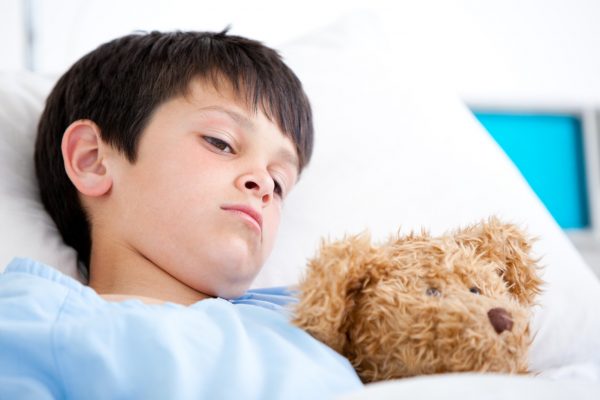
Most often it is in an inactive state in the human body, but as soon as immunity decreases, it manifests itself, causing lesser or greater symptoms.
Usually, a person does not even think about the fact that he is carrying infectious mononucleosis and perceives the disease as a banal ARVI, but in some cases, when the viral load of the blood is higher than usual, the immune response is sluggish, and the body is exhausted by something and cannot resist the disease, a full-fledged the development of the disease.
Previously, mononucleosis was called the "kissing disease", because only young people aged 14-25 were sick with them, but with the development of medical diagnostics, IFA and PCR tests, it is possible to diagnose this disease in young children and adults.
Children who suffer the most are early age become infected with the causative agent of the disease. As statistics show, more than 80% of children are infected with this virus by the age of 3.
In connection with such a prevalence, every mother should know what is "Infectious mononucleosis" in children, symptoms and its treatment. Komarovsky, in his books, talks about the first signs of this disease, the possibilities of getting infected with it and the mechanism of the development of the disease, influencing which you can choose an effective and safe treatment.
Where can you get infectious mononucleosis?
 The source of this disease is an exceptionally sick person, a person with an erased form of the disease, or a person carrying the virus. The transmission of the pathogen occurs through sneezing, coughing, talking or kissing, when saliva is exchanged.
The source of this disease is an exceptionally sick person, a person with an erased form of the disease, or a person carrying the virus. The transmission of the pathogen occurs through sneezing, coughing, talking or kissing, when saliva is exchanged.
The route of infection through infected blood from the donor to the recipient is not excluded. In this case, children suffer the most. Because immunity has not yet formed at the age of 16, the body still does not have a sufficient amount of immunoglobulins that are able to fight the virus.
Therefore, the resulting mononucleosis in children, its symptoms and treatment Komarovsky recommends to evaluate and carry out exclusively in a hospital. The danger of the parenteral route of infection in this case is that the main immune barrier - the mucous membranes of the respiratory tract - is not included in the immune defense chain.
It is in them that most of the virus always dies. During a blood transfusion or organ transplant that is infected with the Epstein-Barr virus, the pathogen enters the bloodstream immediately, where it collides with its target - B-lymphocytes.
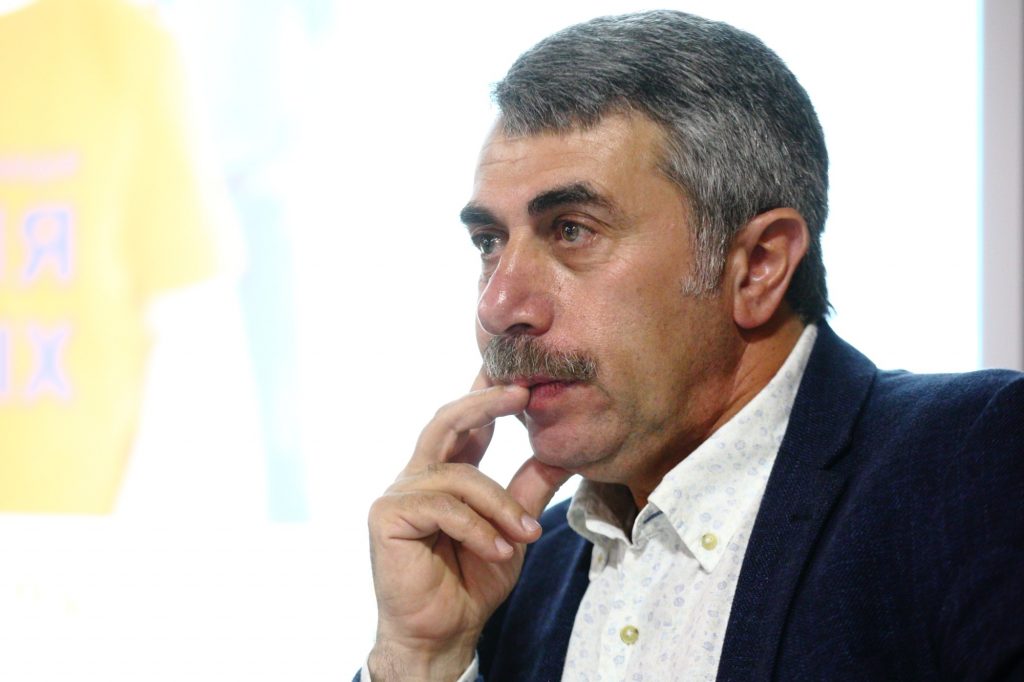
This disease is very rare after 40 years. Most likely, this is due to the fact that the virus has been in the body for a very long time, and a large number of antibodies and immunoglobulins have been produced for it for a long time, which actively fight against it.
Pathogenesis of the development of kissing disease
Epstein-Barr virus enters the oropharynx through the nose or oral cavity... In children, the virus most often gets
through the nasal passage with dust. This mechanism is more common due to the anatomical difference between the nasal passages of children and adults, in a child they are shorter and wider. On the surface of the B-lymphocyte there is a receptor to which the virus is attached and penetrates the cell.
In the acute phase of the disease, viruses infect more than 20% of cells, while the phase of stable remission is characterized by the presence of only 1-2% of infected B-lymphocytes. Gradually, the infected cells die off, and the virus infects more and more targets. An increase in the production of blood cells leads to a gradual accumulation of atypical mononuclear cells, which are characteristic only of the disease "Mononucleosis".
In children, symptoms and treatment, Dr. Komarovsky recommends starting with an assessment clinical analysis blood, the results of which clearly show the number of atypical mononuclear cells. Only the number of these cells more than 10% speaks precisely of the presence of an infectious disease. There are many infectious pathologies that cause a similar blood condition due to the lymphoid response of the immune system to the virus. These include viral hepatitis, yersiniosis, leptospirosis, meningitis, etc.
All lymph nodes in the body are gradually affected, which disrupts the body's immune response and leads to secondary infections. Often giving a more pronounced clinical picture, which leads to an incorrect diagnosis.
Symptoms and course of the disease
 The incubation period of the disease is approximately 4-15 days, on average 6-7 days. The disease begins acutely, most often with severe weakness, an increase in body temperature to 38-40 ° C, which, if untreated, lasts about 14-21 days. The patient is worried headache, weakness, muscle aches. At this stage, it is necessary to conduct differential diagnosis with the flu or a common cold with a severe course.
The incubation period of the disease is approximately 4-15 days, on average 6-7 days. The disease begins acutely, most often with severe weakness, an increase in body temperature to 38-40 ° C, which, if untreated, lasts about 14-21 days. The patient is worried headache, weakness, muscle aches. At this stage, it is necessary to conduct differential diagnosis with the flu or a common cold with a severe course.
Infectious mononucleosis is treated only in a hospital setting. Every pediatrician should know the disease "Mononucleosis" in children: symptoms and treatment. Komarovsky in the video about this disease says that the signs viral nature any disease is a combination of facts:
- Sharp start
- Absence of pronounced catarrhal phenomena (runny nose, wet cough)
- A sharp rise in body temperature to high numbers
A vivid symptom of the manifestation of infectious mononucleosis is angina (tonsillitis) or inflammation of the mucous membrane of the oropharynx. This symptom appears from 4-5 days of illness.
In the same period, it is easy to determine the increase in lymph nodes in different groups. The submandibular is most often affected. In severe conditions, the inguinal and axillary lymph nodes increase.
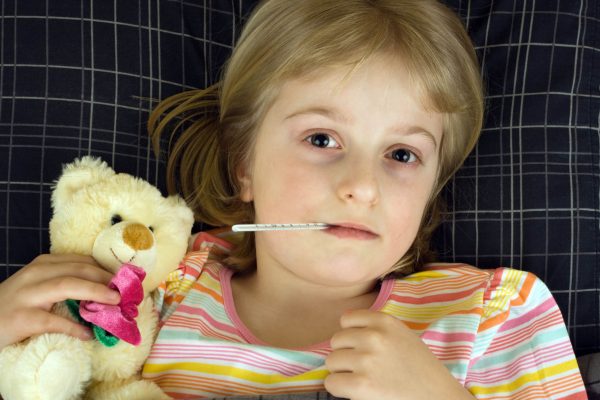
In 25% of cases, on the 3-5th day of illness, a polymorphic rash occurs, which can be periodic or constant (2-3 days).
An objective examination of the abdominal cavity can easily determine a painless enlargement of the liver and spleen. An enlarged liver may be accompanied by signs of slight yellowness of the skin and sclera, which is sometimes regarded as a sign of hepatitis, yersiniosis or pseudotuberculosis. Differentiating these diseases will help a thorough questioning of the patient for a case in which he could become infected with this or that disease.
In peripheral blood, there is an increase in the number of leukocytes, atypical mononuclear cells of more than 10%, an increase in ESR.
Due to the wide variety of symptoms that this pathology manifests itself, a doctor of any specialty must know what mononucleosis in children is: its symptoms and treatment. Komarovsky in the photo shows a lot of children, whose state of health was not timely correctly assessed not only by parents, but also by doctors. Such indifference to the child leads in many cases not only to a severe course of the disease, but also to death.
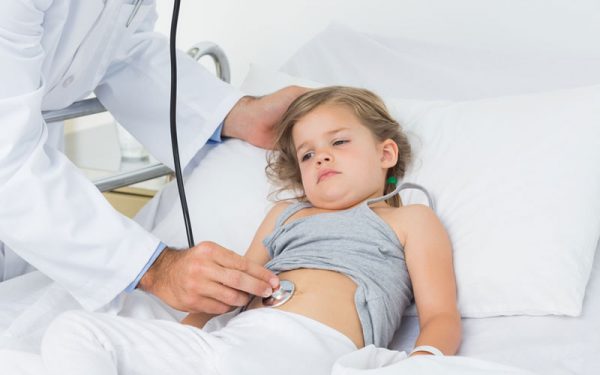
Severe liver pathology, which is accompanied by the destruction of its cells, very quickly causes hepatic coma in the child's body and leads to the death of the child. Disruption in the blood system can lead to anemia, rupture of the spleen, which is very common reason death in patients with infectious mononucleosis.
Sometimes paralysis, paresis, psychosis are observed, which are associated not only with the action of the virus, but also with the action of the body's waste products, which must be neutralized by a healthy liver.
Treatment of infectious mononucleosis
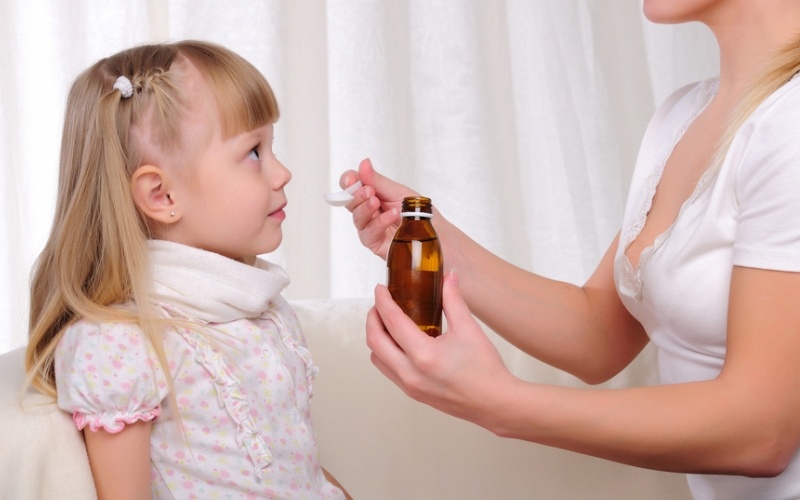 In a mild form, detoxification therapy is used, which consists of drinking plenty of fluids, taking a large amount of vitamins, immunomodulators and stimulants of plant origin (eleutherococcus, lemongrass tincture), interferons.
In a mild form, detoxification therapy is used, which consists of drinking plenty of fluids, taking a large amount of vitamins, immunomodulators and stimulants of plant origin (eleutherococcus, lemongrass tincture), interferons.
For moderate and severe forms of the disease, antibiotics are used, antiviral drugs, inducers of endogenous interferon, powerful detoxification therapy (rheopolyglucin, reamdirin, riboxin, trisol, ascorbic acid).
In a hospital setting, steroid anti-inflammatory drugs can be used, because they perfectly reduce body temperature and improve the patient's condition.
From the above information, it must be concluded that there is a very insidious disease "Mononucleosis" in children: the symptoms and treatment that Komarovsky describes have reviews from parents whose children were sick. In all cases, the reviews are extremely positive.
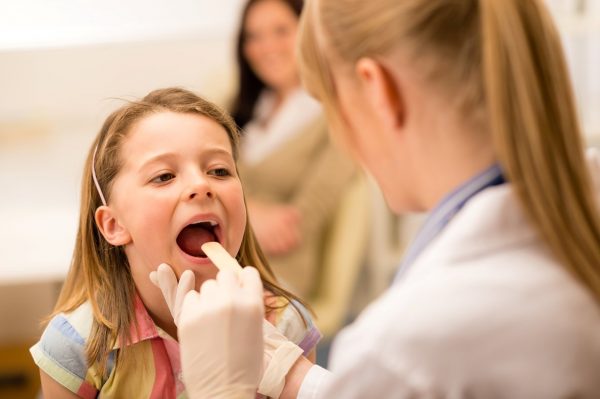
You should not treat a child for a disease similar to infectious mononucleosis at home, because there are many other diseases that are similar in clinical presentation, go to the hospital, get tested and then calmly treat yourself at home on the recommendation of an experienced specialist.
Few have heard about this disease, and those who have heard believe that it is very rare and very terrible. In fact, if you are already an adult, then - 95% guaranteethat you already had this disease. Dr. Komarovsky tells all about this.
This is a viral disease, and the virus of infectious mononucleosis is found in almost all secretions of the human body, but it can only be infected with extremely close contacts. The incubation period of the disease is 1-2 months. And this disease cannot be prevented.
Previously, this disease was called glandular fever, but then it was discovered with it the presence in the blood of monocytes (a type of leukocytes), which change in a special way, they are called mononuclear cells. Hence the current name of the disease. Later, in 1963 scientists Epstein and Barr talked about a virus that can be found in the blood in the presence of this disease, and called it the Epstein-Barr virus. He is the causative agent of mononucleosis. Therefore, this disease is often called EBV infection.



Most people (85%) have no symptoms of this disease.... By the age of 5, at least 50% can have antibodies to infectious mononucleosis. You can also get sick with this disease again. Almost all people on earth were sick with it.
This diagnosis is rarely pronounced, so over-treatment is often prescribed. For example, there is often a similar situation when a child is diagnosed with tonsillitis. Angina is a bacterial infection and with it there can be no runny nose. And if a child has a sore throat and a runny nose is present, then most likely he has mononucleosis. And treatment can be prescribed with antibiotics. There are 2 popular antibiotics: amoxicillin and ampicillin. If given with mononucleosis, then in 85% of cases, this will lead to the appearance of a rash, because a contraindication to their use is mononucleosis.
Infectious mononucleosis causes quite obvious symptoms - damage to lymphoid tissue (tonsils, lymph nodes, adenoids, liver, spleen), hence:
- highly strong pain in the throat;
- the nose is blocked, snoring is possible;
- heat.
There are no cures for mononucleosis. And from him all recover. Treatment here is only symptomatic.
Mononucleosis in children is infection, transmitted by airborne droplets. The danger of the disease is due to the fact that it is very difficult to recognize it at the beginning of infection. The symptoms of the disease are very similar to the usual sore throat and SARS.... That is why parents need to be vigilant and, without wasting time, go to the clinic.
Mononucleosis in children occurs due to the acquired herpesvirus Epstein-Bar. It was first described in 1964 by Canadian researchers, and called it by its proper names. Infectious mononucleosis in children is transmitted from an infected patient. For example, if a child uses only toys, sleeps in the same bed or eats from the same dish with an infected person. The infection spreads to the upper airways, affects the mucous membrane and lymph nodes.
Infection occurs when new cells begin to be produced in the child's body instead of group B lymphocytes. In the last century in Europe, the disease was called "student disease", since most often young people under the age of 20-25 suffered from it. However, doctors say that viral mononucleosis in children now occurs several times more often than in boys and girls.
Doctors call this disease one of the most insidious, since at the initial stage it does not manifest itself in any way. The first symptoms of infectious mononucleosis in children are uncharacteristic fatigue and lethargy in the baby, after 1-2 days - sharp rise temperatures up to 38-39C. On the third or fourth day, the cervical and submandibular lymph nodes significantly increase in size, the skin color becomes yellowish, due to the increase in the size of such internal organs as the liver and spleen.
Almost all cases of the disease at an early age give complications. The consequences of mononucleosis in children are nasal congestion and affected nasopharynx and tonsils, resulting in adenoids and chronic tonsillitis.
Another symptom of mononucleosis in children is sudden onset of snoring during sleep. As soon as you hear that the baby starts snoring in a dream, pay attention to the tonsils. On closer inspection, you will notice the formation of a white film coating on them. Such signs of sore throat, plus the appearing pain when swallowing, confuse parents, preventing them from further examining the baby. Starting to treat tonsillitis, parents understand that something goes wrong only when the child becomes worse 4-5 days after treatment, and the temperature is already approaching 39-40C.
Another characteristic symptom is a rash with mononucleosis in children. Since the virus is a herpes virus, small watery pimples may appear on the skin and mucous membranes. They look like a common red rash caused by allergic reactions, and this is another factor that parents are at early stages do not immediately understand what exactly their child is sick with.
The atypical form of mononucleosis in children occurs without pronounced signs of the disease or in the presence of only some of them. Sometimes the ailment is expressed only in enlarged lymph nodes or yellowness of the skin. In some cases, the disease can be diagnosed only after passing the necessary tests, since the baby does not have visual changes and physical ailment.
Signs of mononucleosis in children, as we can see, can be different, but the main ones are enlarged lymph nodes, high fever and pain in the joints and muscles, should be the first signals for you and your baby to see a doctor.
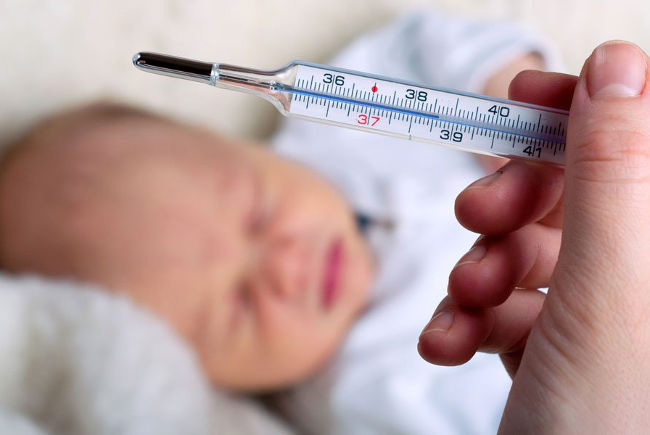
Treatment of mononucleosis in children
To date, there are no specific measures and specific treatment for mononucleosis. Even the multiplication activity of the virus cannot be suppressed by any specific pharmaceutical preparation. Treatment of infectious mononucleosis in children is possible in two directions:
- The first stage the main symptoms are removed and measures for pathogenic therapy are carried out. They include the appointment of antipyretic drugs (Paracetamol, Ibuprofen, etc.)
- Second phase treatment of infectious mononucleosis in children is antiseptic measures to block tonsillitis, restorative and vitamin therapy. Against this background, the child is prescribed immunotherapy and desensitizing drugs.
The well-known children's doctor Komarovsky recommends adding hepatoprojectors and choleretic agents in the case when the disease has affected the deformation and enlargement of the child's internal organs. Treatment of mononucleosis in children, according to Komarovsky, in this case is impossible without revising the diet.
Moreover, in the case of the appointment of a diet for mononucleosis, it is necessary to consider not only those products that are able to loyally and gently normalize and improve the work of internal organs, but also increase the immune and protective properties of the body.
Treatment of mononucleosis in children with a diet implies a balanced diet, consisting mainly of antioxidants, which remove radicals and products from the blood and the body that interfere with normal metabolism. In addition, in case of ailment, it is not recommended to eat foods containing saturated and animal fats.
The diet includes the maximum amount of liquid, vegetables and fruits, whole grains. Drinking is limited to 8-10 glasses a day. Moreover, it can be not only water, but also juices, herbal infusions, vegetable soups and broths.
Chronic mononucleosis in children - a disease that has spilled over into chronic stage due to weakened immunity in the baby. The right treatment, daily routine and diet can cure mononucleosis quite quickly. It is very important not to stop treatment and completely go through the entire course prescribed by the doctor, even if the condition has improved within a few days. The chronic form appears in a baby if the symptoms persist for 6 months or more. At the same time, tests for mononucleosis in children show an increase in monocytes and leukocytes in the blood characteristic of the disease.
The main thing that parents need to remember is that mononucleosis is a disease that does not pose a danger and threat to the child's life, if it is detected in the early stages and treatment is started in a timely manner. Maintain close contact with your local pediatrician or family doctor. Be sure to consult and seek help if you feel the slightest discomfort or if you see symptoms that are unfamiliar to you.
